 |
 |
 |
| |
***** Best CROI Poster Award by NATAP *****
Immune Senescence, Activation and Abnormal T cell Homeostasis Despite Effective HAART, A Hallmark of Early Aging in HIV Disease
|
| |
| |
Reported by Jules Levin
CROI 2009 Montreal Feb 8-12
Seema Desai*1, Rollie Ronquillo1, Xiomara Usuga1, Jeffrey Martinson1, Oluwatoyin Adeyemi1,2, Allan Tenorio1, and Alan Landay1
Rush University Medical Center,RUSH University Medical Center 1 and Stroger Hospital of Cook County2 Chicago, IL, US
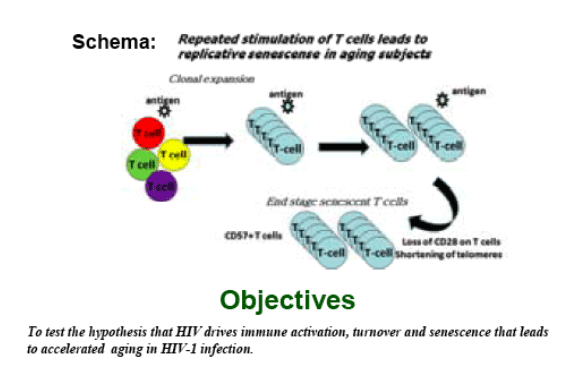
AUTHOR OBSERVATIONS
Age dependant changes in CD8+ T cells are more pronounced than in CD4+ T cells in HIV-1 infected and Aging individuals. Significantly higher degree of immune senescence (measured as loss of CD28 and CD57 expression) was observed in CD8+ T cells compared to CD4+ T cells in HIV-1 infected and older uninfected subjects compared to young uninfected subjects.
Reduction in naive T cells and accumulation of terminal effectors in both CD4+ and CD8+ T cells was observed with significant differences in CD8+ T cells of HIV-1 infected and older HIV uninfected subjects compared to young HIV negative subjects. Suggesting, that CD8+ T cells are more susceptible to fragile
homoestatic control than CD4+ T cells. CD4+ and CD8+ Central Memory T cells were significantly reduced in HIV-1 infected subjects compared to older HIV negative subjects (data not shown).
Immune activation drives T cell turnover and senescence in HIV-1 infected and uninfected aging individuals as indicated by significantly higher levels of activation (expression of CD38+HLADR+) on both CD4+ and CD8+ T cells of HIV-1 infected and uninfected aging individuals compared to young uninfected subjects.
Whether regulatory T cells play a role in controlling immune activation needs to be further elucidated. Larger cohort studies are warranted.
AUTHOR CONCLUSION
Based on the phenotypic characteristics in HAART suppressed HIV-1 infected subjects, it can be concluded that early senescence (aging) occurs, as HIV-1 infected subjects (median 53 y) with good immune reconstitution and viral suppression had immune changes comparable to older (median 88y) HIV-1 negative subjects. These findings have implications on the competency of adaptive immune system & its ability to combat infections.
ABSTRACT
Background: The introduction of HAART has improved HIV-1 survival, such that many individuals who contracted HIV-1 infection early in the epidemic are now living to an older age. Several immunological alterations that characterize HIV-1 infection are similar to those associated with normal aging. We tested the hypothesis that HIV-1 drives immune activation, turnover and senescence that
leads to accelerated aging in HIV-1 infection.
Method: We evaluated 10 HIV-1 infected HAART suppressed individuals (median age 56 y, viral loads <50 copies/mL, CD4 counts, median 724 cells/mm3); 10 older HIV-1 negative subjects (median age 88 y) and 5 HIV-1 negative young controls (median age 27y) for markers of immune senescence
(CD57+ CD28-), immune activation (CD38+HLADR+) and regulatory T cells
(CD4+CD25hiCD127lo). We evaluated naive, memory and effector T cell subsets based on expression of CD45RA CCR7. Studentfs t-test and one-way ANNOVA for comparison within groups was used for statistical analysis.
Results:
In HIV-1 infected and older HIV negative subjects, significantly higher (p<0.001) frequency of senescent CD8+ T cells (CD57+CD28-) were found compared to HIV negative young controls.
Immune activation (CD38+HLADR+) was significantly higher in CD8 T cells compared to CD4+T cells in HIV-1 infected subjects(p<0.002).
The degree of CD8+ T cell activation was higher in HIV-1 infected compared to older HIV negative subjects and HIV negative young controls (p<0.01).
Regulatory T cell frequencies were equivalent in the HIV-1 infected and older HIV negative group and were higher than HIV negative young controls.
Naive CD4+ and CD8+ T cells were significantly reduced in HIV-1 infected and older HIV negative subjects compared to HIV negative young controls with proportional increase in terminally differentiated effector T cells.
CD4+ and CD8+ Central Memory T cells were significantly reduced in HIV-1 infected subjects compared to older HIV-1 negative subjects (p<0.001 in both subsets).
Conclusion: HIV-1 infected subjects (median 56 y) with good immune reconstitution and viral suppression had immune changes comparable to older (median 88y) HIV negative subjects. Age dependant changes in HIV-1 infected compared to young HIV negative controls are more pronounced in CD8+ T cells which exhibit higher immune activation and senescence levels and reduced naive and central memory subsets. These findings have implications on the competency of adaptive immune system & its ability to combat infection.
MATERIAL & METHODS
Study population: 18 HIV-1 infected HAART suppressed individuals, median age 53 years (41-59) were recruited in this study with CD4 counts>500 cells/mm3 and viral load <50 copies/mL, median CD4 count 745 cells/mm3 ( 566-1213). Aging HIV negative subjects (n=10) were recruited from Minority Aging Research Study at RUSHfs Alzheimerfs disease core centre median ages 88 years (75-93). Young HIV-1 negative subjects (n=5) median age 27 (23-29) were included in the study.
Methods
Markers of immune senescence: PBMC from three groups of study subjects were treated with anti human antibodies CD3/CD4/CD8/CD28/CD57. Cells were washed and fixed in 1% Para Formaldehyde until acquisition on LSRII (Beckton Dickinson CA ). Data was analyzed using Flow Jo software (Tree Star Inc). C28 and C57 expression was gated to respective fluorescence minus one controls. Replicative senescence will be measure as loss of CD28 and expression of CD57.
Phenotyping cellular markers of immune activation:
Markers of activation CD38 and HLA-DR on CD4+ and CD8+ T cells were evaluated in three study groups. PBMCs were be stained using the anti human monoclonal antibodies CD3/CD4/CD8/CD38 /HLA-DR. Fluorescence Minus one controls were included for HLADR and CD38.
Regulatory T cells: Regulatory T cells were enumerated based on their expression of CD3+CD4+CD25hi CD127lo in three study groups. 5 additional young HIV-1 negative subjects were used for comparison.
T cell Subtypes: Naive, memory and effector T cell subsets were assessed based on expression of CD45RA CCR7 in both CD4 and CD8 T cell subsets. Naive T cells were defined as CD45RA+CCR7+, Central Memory as CD45RA-CCR7+ Effector Memory CD45+CCR7- and terminal effectors as CD45RA+CCR7-
Statistical analysis: Nonparametric analysis, One-way analysis of variance (ANOVA) test with planned comparisons to compare pairs of groups was used.
BACKGROUND
Over 25 years into the HIV epidemic the number of HIV-1 infected have moved to the
older ages due to improvements in anti retroviral therapy.
Declining immune system is hallmark of aging. Chronic immune activation and persistent infections in HIV-1 infected individuals provide a milieu for accelerated replicative senescence of T cells that progressively accumulate during the normal course of aging.
An increasing number of investigators have reported osteoporosis, atherosclerosis,
neurocognitive decline and frailty in HIV-1 infected patients. Thus physiological alterations and co-morbidities suggest that advanced aging occurs in HIV disease.
During aging, a reduction in T cell renewal, together with a progressive enrichment of
terminally differentiated T cells with shortened telomeres, translate into a general decline of the immune system, gradually leading to immune senescence. (schema).
We examine whether impairment in T cell differentiation and immune activation are likely mechanisms of early immune senescence in HIV-1 infection.
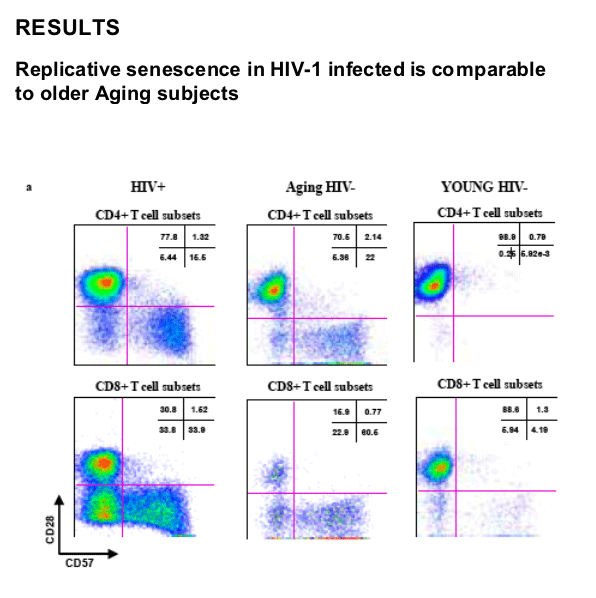
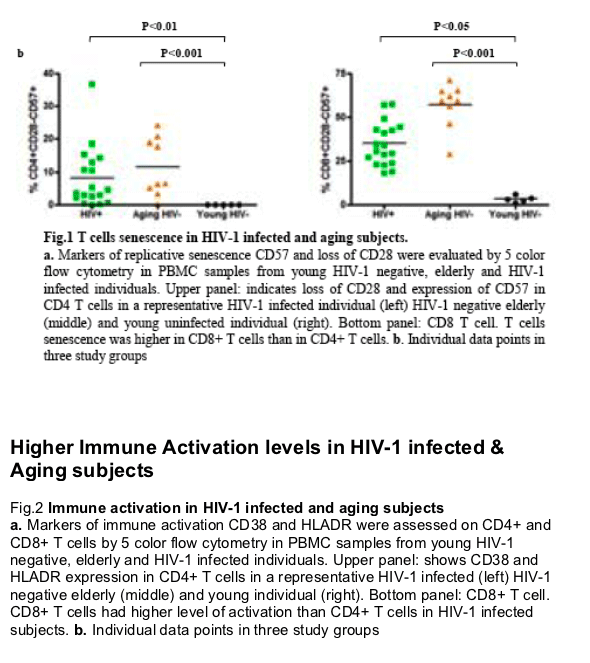
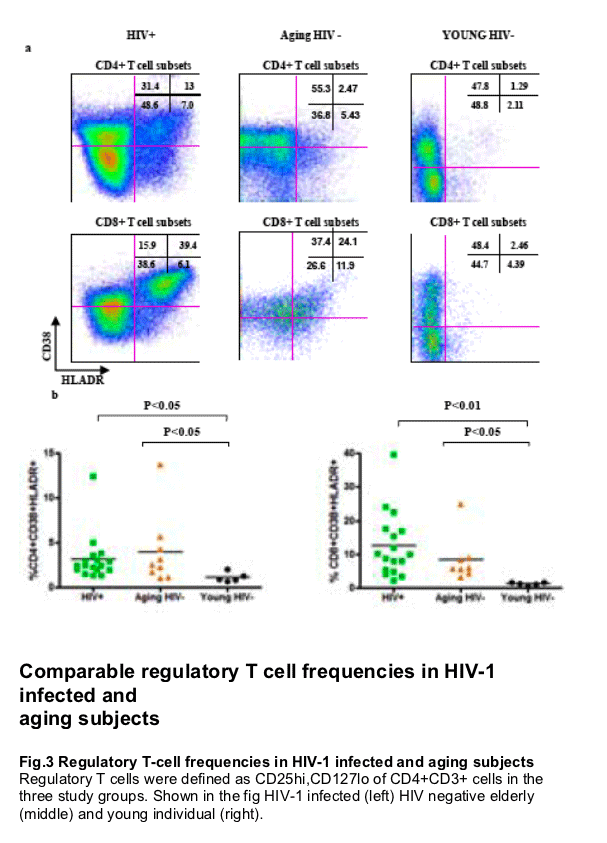
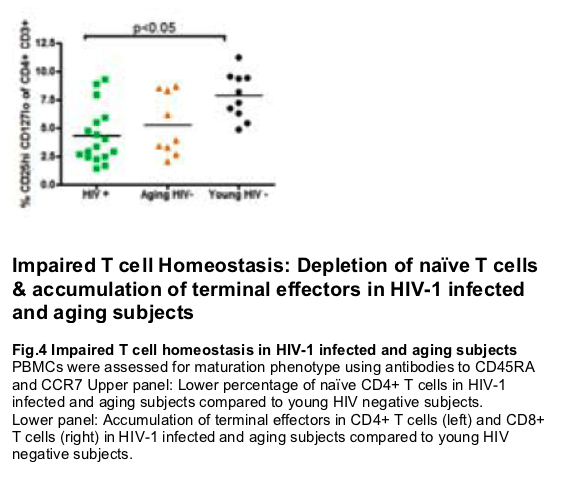
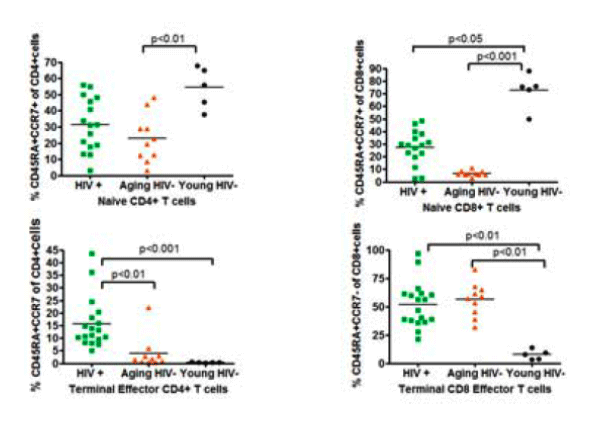
|
| |
|
 |
 |
|
|